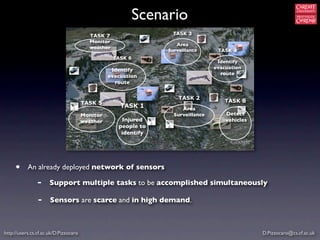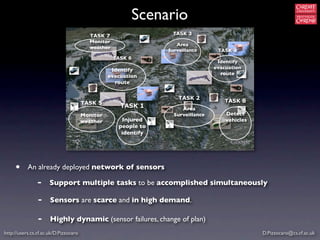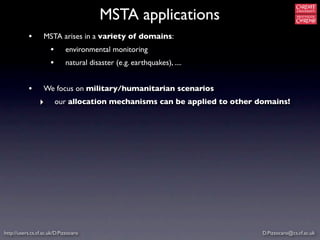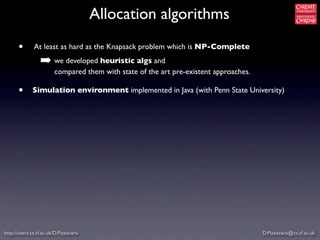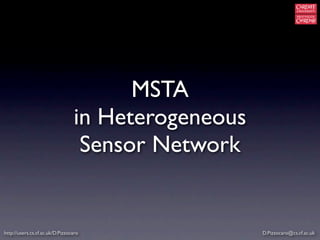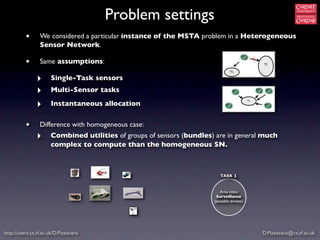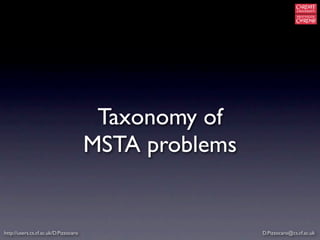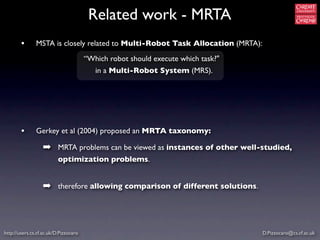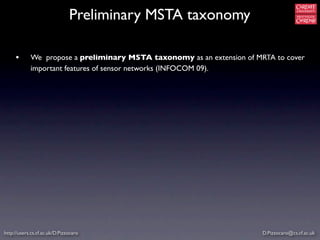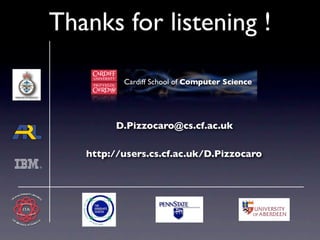On Multi-Sensor Task Allocation
- 1. Seminar @ DEI Cardiff School of Computer Science University of Padova (Italy) April, 2009 On Multi-Sensor Task Allocation Diego Pizzocaro PhD candidate Supervisors: Prof. Alun Preece - Dr. Roger Whitaker http://users.cs.cf.ac.uk/D.Pizzocaro [email protected]
- 2. Brief Bio • 2007 - Computer Engineering, University of Padova (Italy), supervised by Prof. Luca Schenato • 2008 - Start PhD in Computer Science at Cardiff University (UK), supervised by Prof. Alun Preece and Dr. Roger Whitaker • International Technology Alliance (ITA) project: multi-national teams supported by complex information networks U.K. Ministry of Defence U.S. Army Research Lab • Our research focus: intelligent resource allocation in sensor networks. http://users.cs.cf.ac.uk/D.Pizzocaro [email protected]
- 3. Outline 1. Motivations & MSTA problem 2. MSTA in Homogeneous Sensor Network 3. MSTA in Heterogeneous Sensor Network 4. Taxonomy of MSTA problems 5. Conclusion http://users.cs.cf.ac.uk/D.Pizzocaro [email protected]
- 4. Motivation & MSTA problem http://users.cs.cf.ac.uk/D.Pizzocaro [email protected]
- 5. Sensors Simple sensors Platforms http://users.cs.cf.ac.uk/D.Pizzocaro [email protected]
- 6. Sensors Simple sensors Platforms http://users.cs.cf.ac.uk/D.Pizzocaro [email protected]
- 7. Sensors Tasks Simple sensors e.g. Search-&-Rescue mission Platforms http://users.cs.cf.ac.uk/D.Pizzocaro [email protected]
- 8. Sensors Tasks Simple sensors e.g. Search-&-Rescue mission TASK 3 TASK 4 Area Surveillance Area (possible threats) TASK 1 Platforms Surveillance (possible threats) Injured people to TASK 2 identify Injured people to identify http://users.cs.cf.ac.uk/D.Pizzocaro [email protected]
- 9. Scenario http://users.cs.cf.ac.uk/D.Pizzocaro [email protected]
- 10. Scenario • An already deployed network of sensors http://users.cs.cf.ac.uk/D.Pizzocaro [email protected]
- 11. Scenario TASK 3 TASK 7 Monitor Area weather Surveillance TASK 4 TASK 6 Identify Identify evacuation route evacuation route TASK 2 TASK 5 TASK 8 TASK 1 Area Monitor Surveillance Detect weather Injured vehicles people to identify • An already deployed network of sensors - Support multiple tasks to be accomplished simultaneously http://users.cs.cf.ac.uk/D.Pizzocaro [email protected]
- 12. Scenario TASK 3 TASK 7 Monitor Area weather Surveillance TASK 4 TASK 6 Identify Identify evacuation route evacuation route TASK 2 TASK 5 TASK 8 TASK 1 Area Monitor Surveillance Detect weather Injured vehicles people to identify • An already deployed network of sensors - Support multiple tasks to be accomplished simultaneously - Sensors are scarce and in high demand. http://users.cs.cf.ac.uk/D.Pizzocaro [email protected]
- 13. Scenario TASK 3 TASK 7 Monitor Area weather Surveillance TASK 4 TASK 6 Identify Identify evacuation route evacuation route TASK 2 TASK 5 TASK 8 TASK 1 Area Monitor Surveillance Detect weather Injured vehicles people to identify • An already deployed network of sensors - Support multiple tasks to be accomplished simultaneously - Sensors are scarce and in high demand. - Highly dynamic (sensor failures, change of plan) http://users.cs.cf.ac.uk/D.Pizzocaro [email protected]
- 14. Scenario “Where is it better to send that particular UAV?” TASK 2 TASK 1 Area Surveillance Injured people to identify • An already deployed network of sensors - Support multiple tasks to be accomplished simultaneously - Sensors are scarce and in high demand. - Highly dynamic (sensor failures, change of plan) http://users.cs.cf.ac.uk/D.Pizzocaro [email protected]
- 15. MSTA problem • We need schemes to allocate sensors to the task they best serve, considering all the relevant parameters. • In general we can have • static or mobile sensing devices • tasks requiring multiple sensors or one sensor • sensors shared or not shared between multiple tasks • etc... http://users.cs.cf.ac.uk/D.Pizzocaro [email protected]
- 16. MSTA problem • We need schemes to allocate sensors to the task they best serve, considering all the relevant parameters. • In general we can have • static or mobile sensing devices • tasks requiring multiple sensors or one sensor • sensors shared or not shared between multiple tasks • etc... • The fundamental question remains: Which sensor should be allocated to which task? http://users.cs.cf.ac.uk/D.Pizzocaro [email protected]
- 17. MSTA problem • We need schemes to allocate sensors to the task they best serve, considering all the relevant parameters. • In general we can have • static or mobile sensing devices • tasks requiring multiple sensors or one sensor • sensors shared or not shared between multiple tasks • etc... • The fundamental question remains: Which sensor should Multi-Sensor Task Allocation be allocated to which task? (MSTA) http://users.cs.cf.ac.uk/D.Pizzocaro [email protected]
- 18. MSTA applications • MSTA arises in a variety of domains: • environmental monitoring • natural disaster (e.g. earthquakes), .... http://users.cs.cf.ac.uk/D.Pizzocaro [email protected]
- 19. MSTA applications • MSTA arises in a variety of domains: • environmental monitoring • natural disaster (e.g. earthquakes), .... • We focus on military/humanitarian scenarios ‣ our allocation mechanisms can be applied to other domains! http://users.cs.cf.ac.uk/D.Pizzocaro [email protected]
- 20. MSTA applications • MSTA arises in a variety of domains: • environmental monitoring • natural disaster (e.g. earthquakes), .... • We focus on military/humanitarian scenarios ‣ our allocation mechanisms can be applied to other domains! • The task allocation process differs a lot when ‣ in a homogeneous sensor network (e.g. only seismic sensors) ‣ in a heterogeneous sensor network (e.g. seismic+UAVs+UGVs) http://users.cs.cf.ac.uk/D.Pizzocaro [email protected]
- 21. MSTA applications • MSTA arises in a variety of domains: • environmental monitoring • natural disaster (e.g. earthquakes), .... • We focus on military/humanitarian scenarios ‣ our allocation mechanisms can be applied to other domains! • The task allocation process differs a lot when ‣ in a homogeneous sensor network (e.g. only seismic sensors) ‣ in a heterogeneous sensor network (e.g. seismic+UAVs+UGVs) • We discuss two examples of MSTA instances in both networks http://users.cs.cf.ac.uk/D.Pizzocaro [email protected]
- 22. MSTA in Homogeneous Sensor Network http://users.cs.cf.ac.uk/D.Pizzocaro [email protected]
- 23. Why Homogeneous SN ? • Governmental institutions (ARL, MoD), and researchers suggest Wireless Sensor Networks (WSNs) as “the future” for military operations. http://users.cs.cf.ac.uk/D.Pizzocaro [email protected]
- 24. Why Homogeneous SN ? • Governmental institutions (ARL, MoD), and researchers suggest Wireless Sensor Networks (WSNs) as “the future” for military operations. • WSNs are often composed exclusively by hundreds of cheap miniaturized wireless sensors (called motes) with the same sensing capabilities. http://users.cs.cf.ac.uk/D.Pizzocaro [email protected]
- 25. Why Homogeneous SN ? • Governmental institutions (ARL, MoD), and researchers suggest Wireless Sensor Networks (WSNs) as “the future” for military operations. • WSNs are often composed exclusively by hundreds of cheap miniaturized wireless sensors (called motes) with the same sensing capabilities. • In general every network composed exclusively sensors with the same sensing capabilities is called “Homogeneous Sensor Network”. http://users.cs.cf.ac.uk/D.Pizzocaro [email protected]
- 26. Problem settings • We considered a particular instance of the MSTA problem in a Homogeneous Sensor Network (see DCOSS 08). • Assumptions: ‣ Sensors can serve only one task per time: Single-Task sensors - Therefore tasks are competing for the exclusive usage of a sensor x T2 T1 ‣ A task might require more than one sensor: Multi-Sensor tasks T1 ‣ Available info does not permit planning for future: Instantaneous allocation http://users.cs.cf.ac.uk/D.Pizzocaro [email protected]
- 27. Formal model • Tasks: Sensors ‣ vary in priority S1 (e11, c11 Tasks ) ‣ have a different demand for sensing resource (e 12 ,c (p1, d1, b1) capabilities T1 12 ) ‣ have to respect a budget (e.g. monetary). S2 • Each sensor: T2 (p2, d2, b2) ‣ S3 has a different utility for each task (e.g. geography & distance) ‣ has a different cost for each task. S4 e = utility of sensor to a task • Goal: c = cost of a sensor to a task maximizes the utility p = task priority while not exceeding the budgets of each task. d = task utility demand b = task budget http://users.cs.cf.ac.uk/D.Pizzocaro [email protected]
- 28. Allocation algorithms • At least as hard as the Knapsack problem which is NP-Complete ➡ we developed heuristic algs and compared them with state of the art pre-existent approaches. • Simulation environment implemented in Java (with Penn State University) http://users.cs.cf.ac.uk/D.Pizzocaro [email protected]
- 29. Allocation algorithms • At least as hard as the Knapsack problem which is NP-Complete ➡ we developed heuristic algs and compared them with state of the art pre-existent approaches. • Simulation environment implemented in Java (with Penn State University) • The algorithm which offers the best trade-off optimality Vs computational cost: MRGAP algorithm: ‣ a centralized algorithm: i.e. we collect all the info about the network in a single node ‣ it can be easily implemented as a distributed algorithm: less communication overhead. http://users.cs.cf.ac.uk/D.Pizzocaro [email protected]
- 30. MSTA in Heterogeneous Sensor Network http://users.cs.cf.ac.uk/D.Pizzocaro [email protected]
- 31. Why Heterogeneous SN ? • Sensor network deployment during military/humanitarian missions: ‣ UAV will fly on the battlefield and drop hundreds of motes ‣ Some motes might also be mobile. http://users.cs.cf.ac.uk/D.Pizzocaro [email protected]
- 32. Why Heterogeneous SN ? • Sensor network deployment during military/humanitarian missions: ‣ UAV will fly on the battlefield and drop hundreds of motes ‣ Some motes might also be mobile. • Therefore we have a sensor network composed by sensors with different sensing capabilities and mobility capabilities: “Heterogeneous sensor network” http://users.cs.cf.ac.uk/D.Pizzocaro [email protected]
- 33. Why Heterogeneous SN ? • Sensor network deployment during military/humanitarian missions: ‣ UAV will fly on the battlefield and drop hundreds of motes ‣ Some motes might also be mobile. • Therefore we have a sensor network composed by sensors with different sensing capabilities and mobility capabilities: “Heterogeneous sensor network” • Another example: Sensor Web by Open Geospatial Consortium (OGC) with environmental monitoring applications. http://users.cs.cf.ac.uk/D.Pizzocaro [email protected]
- 34. Problem settings • We considered a particular instance of the MSTA problem in a Heterogeneous Sensor Network. x • Same assumptions: T2 T1 ‣ Single-Task sensors ‣ Multi-Sensor tasks ‣ Instantaneous allocation T1 • Difference with homogeneous case: ‣ Combined utilities of groups of sensors (bundles) are in general much complex to compute than the homogeneous SN. TASK 1 Area video Surveillance (possible threats) http://users.cs.cf.ac.uk/D.Pizzocaro [email protected]
- 35. Problem settings • We considered a particular instance of the MSTA problem in a Heterogeneous Sensor Network. x • Same assumptions: T2 T1 ‣ Single-Task sensors ‣ Multi-Sensor tasks ‣ Instantaneous allocation T1 • Difference with homogeneous case: ‣ Combined utilities of groups of sensors (bundles) are in general much complex to compute than the homogeneous SN. Sensor bundles TASK 1 Area video Surveillance (possible threats) http://users.cs.cf.ac.uk/D.Pizzocaro [email protected]
- 36. Formal model • We first want to group sensors into bundles, and then we want to find the best assignment of bundles to tasks. Sensors Bundles Tasks S1 e11 B1 T1 (p1) S2 e1 2 S3 B2 T2 (p2) S4 e = joint utility of a bundle to a task p = task priority http://users.cs.cf.ac.uk/D.Pizzocaro [email protected]
- 37. Allocation mechanisms (1) • Problem well studied in Multi-agent Systems: Coalition formation • Typical approach: combinatorial auction ‣ bidders: tasks ‣ items: sensors ‣ tasks bids for bundles of sensors http://users.cs.cf.ac.uk/D.Pizzocaro [email protected]
- 38. Allocation mechanisms (1) • Problem well studied in Multi-agent Systems: Coalition formation • Typical approach: combinatorial auction ‣ bidders: tasks ‣ items: sensors ‣ tasks bids for bundles of sensors • Need to enumerate all possible bundles for each task. • Large number of sensors and tasks: the computational cost is too large. • Our contribution: Prune the set of bids placed by tasks (i.e. reduce the number of possible bundles). http://users.cs.cf.ac.uk/D.Pizzocaro [email protected]
- 39. Allocation mechanisms (2) • We define a system architecture in which we gradually reduce the search space of the allocation algorithms (see EKAW08). http://users.cs.cf.ac.uk/D.Pizzocaro [email protected]
- 40. Allocation mechanisms (2) • We define a system architecture in which we gradually reduce the search space of the allocation algorithms (see EKAW08). • Three main components: Reasoner < Package Config > Sensor types compatible with the task. Bundle Generator { < Bundle1, e1 >, < Bundle2, e2 >, ... } Sensor Bundles generated based on the package configuration. Allocation Algorithms http://users.cs.cf.ac.uk/D.Pizzocaro [email protected]
- 41. Allocation mechanisms (2) • We define a system architecture in which we gradually reduce the search space of the allocation algorithms (see EKAW08). • Three main components: Reasoner < Package Config > Sensor types compatible with the task. Bundle Generator { < Bundle1, e1 >, < Bundle2, e2 >, ... } Sensor Bundles generated based on the package configuration. Allocation Algorithms • Current work: Implementing/Testing this approach using the simulation environment “Player/Stage”. http://users.cs.cf.ac.uk/D.Pizzocaro [email protected]
- 42. Taxonomy of MSTA problems http://users.cs.cf.ac.uk/D.Pizzocaro [email protected]
- 43. Related work - MRTA • MSTA is closely related to Multi-Robot Task Allocation (MRTA): “Which robot should execute which task?" in a Multi-Robot System (MRS). http://users.cs.cf.ac.uk/D.Pizzocaro [email protected]
- 44. Related work - MRTA • MSTA is closely related to Multi-Robot Task Allocation (MRTA): “Which robot should execute which task?" in a Multi-Robot System (MRS). • Gerkey et al (2004) proposed an MRTA taxonomy: ➡ MRTA problems can be viewed as instances of other well-studied, optimization problems. ➡ therefore allowing comparison of different solutions. http://users.cs.cf.ac.uk/D.Pizzocaro [email protected]
- 45. Preliminary MSTA taxonomy • We propose a preliminary MSTA taxonomy as an extension of MRTA to cover important features of sensor networks (INFOCOM 09). http://users.cs.cf.ac.uk/D.Pizzocaro [email protected]
- 46. Preliminary MSTA taxonomy • We propose a preliminary MSTA taxonomy as an extension of MRTA to cover important features of sensor networks (INFOCOM 09). • MSTA taxonomy organized on four main axes: 1. Sensors: Single-task (ST) vs. multi-task (MT). 2. Tasks: Single-sensor (SS) vs. multi-sensor (MS). 3. Assignment: Instantaneous (IA) vs. time-extended (TA). 4. Sensor Network: Homogeneous (HO) vs. heterogeneous (HE). • Example: previously we have considered ST-MS-IA-HO and ST-MS-IA-HE http://users.cs.cf.ac.uk/D.Pizzocaro [email protected]
- 47. Conclusion • We have presented the general MSTA problem, • Discussed two MSTA instances with applications in military/humanitarian missions, • Outlined the need for a MSTA taxonomy and presented a preliminary version of it. http://users.cs.cf.ac.uk/D.Pizzocaro [email protected]
- 48. Conclusion • We have presented the general MSTA problem, • Discussed two MSTA instances with applications in military/humanitarian missions, • Outlined the need for a MSTA taxonomy and presented a preliminary version of it. • Future research: ‣ Refine MSTA taxonomy ‣ What are the most important SN features to include? ‣ Explore different MSTA instances: ‣ Heterogeneous SN with Multi-Task sensors (sensors can be shared) http://users.cs.cf.ac.uk/D.Pizzocaro [email protected]
- 49. Thanks for listening ! Cardiff School of Computer Science [email protected] http://users.cs.cf.ac.uk/D.Pizzocaro












